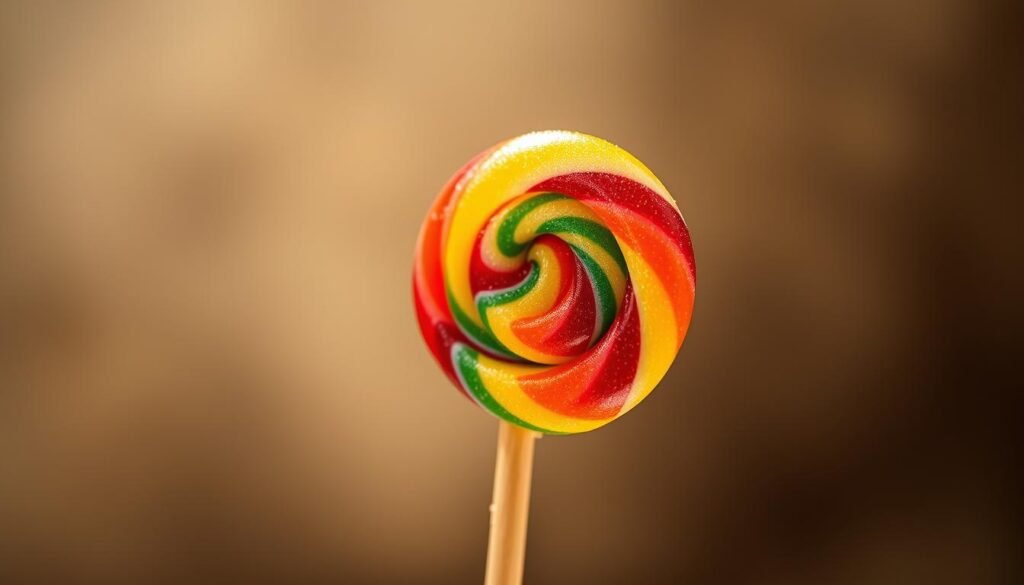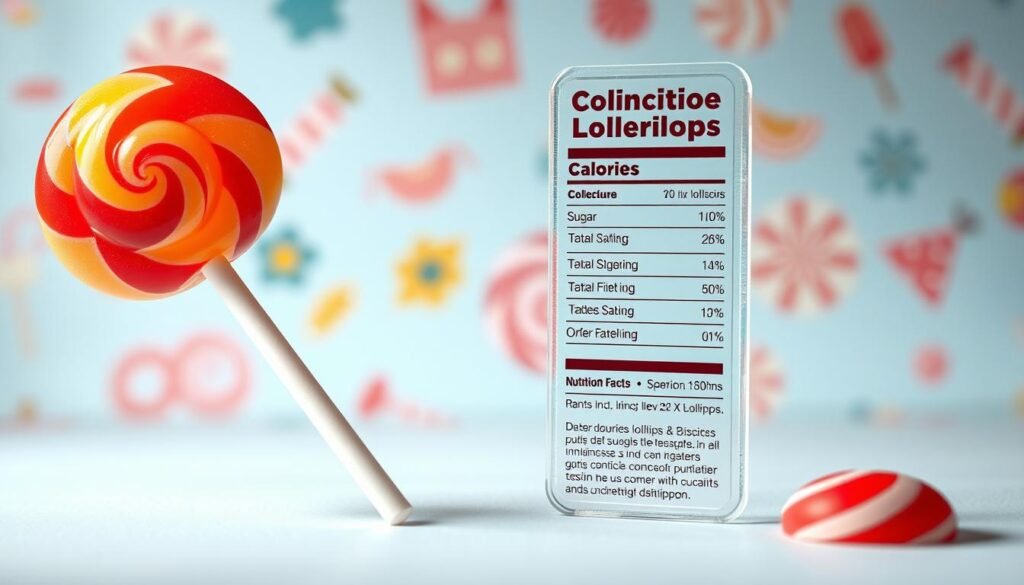Could that colorful treat on a stick be hiding more than just sugar? While lollipops are beloved by kids and adults alike, their nutritional value often sparks debate. Let’s unwrap the truth behind these iconic sweets.
A typical lollipop contains about 50-100 calories, with nearly 10-20 grams of added sugar. That’s close to half the daily recommended limit for adults. Ingredients like corn syrup and artificial flavors dominate, offering little to no vitamins or minerals.
Despite their minimal health benefits, these candies remain popular for their convenience and nostalgic charm. Modern versions even include sugar-free alternatives, using sweeteners like stevia. But do these innovations make them a smarter choice?
This article digs into their history, design, and surprising nutritional insights. We’ll explore how occasional enjoyment fits into a balanced lifestyle—and when it’s time to rethink reaching for that swirl of sweetness.
Key Takeaways
- Most lollipops provide empty calories with high sugar content.
- Artificial colors and flavors are common ingredients.
- Portion control is key for occasional treats.
- Sugar-free options reduce calorie intake but may contain additives.
- Historical popularity doesn’t equal nutritional value.
What Are Lollipops? A Closer Look at This Sweet Treat
Ever wondered what makes these spiral-shaped candies on sticks so irresistible? Known for their vibrant hues and playful designs, these handheld confections combine sugar, flavorings, and food coloring into a hardened form. The stick isn’t just for convenience—it slows consumption, making them last longer than most sugary snacks.

Unlike chewy gummies or melt-in-your-mouth chocolates, lollipops belong to the hard candy family. Their solid texture means they dissolve slowly, extending the sugary experience. This unique format also makes them less messy, ideal for on-the-go enjoyment.
Most varieties pack a hefty dose of sweeteners like corn syrup or sucrose. A single piece can contain up to 20 grams of sugar—equivalent to five teaspoons. While they’re not nutrient-dense, some sugar-free versions use alternatives like xylitol for those monitoring intake.
Moderation remains key. Nutritionists often categorize them as occasional indulgences rather than everyday snacks. Yet their nostalgic charm keeps them popular at parties, holidays, and as small rewards in balanced diets.
From rainbow swirls to novelty shapes, these treats prove that sometimes joy comes in simple, sugary packages. Their role in culture and celebrations underscores why they remain a beloved part of sweet traditions worldwide.
The History and Surprising Origin of Lollipops
Did ancient civilizations crave portable sweets? Evidence suggests people enjoyed honey-dipped fruits on sticks as early as 2000 BCE. These primitive treats laid the groundwork for today’s sugary confections.

Medieval Arabs later boiled sugar with floral extracts, creating early hard candies. By the 16th century, European explorers added sticks for easier handling—a practice documented in culinary archives. Corn syrup’s 19th-century invention revolutionized texture, allowing mass production.
Global cultures put unique spins on the concept. Chinese artisans crafted rock sugar sticks, while Mexican vendors sold tamarind-paste palanquetas. Each version reflected local ingredients and traditions.
Modern versions emerged in the 1920s when automated machines standardized shapes. Sugar intake levels soared as factories prioritized affordability over quality. Today’s recipes balance nostalgia with reduced-sugar alternatives, though classic varieties remain crowd-pleasers.
From royal honey sticks to carnival favorites, this candy’s journey proves innovation often springs from simple cravings. Its evolution mirrors humanity’s enduring sweet tooth—and our knack for turning basic ingredients into joyful indulgences.
Nutritional Overview of Lollipops: Calories, Sugar, and Ingredients
What’s really inside that swirl of sweetness on a stick? A typical piece packs 60-80 calories, with 15-25 grams of carbohydrates—almost entirely from refined sugars. This makes them energy-dense but nutrient-light, offering minimal protein, fiber, or essential vitamins.

Calorie Count Breakdown
Standard-sized varieties range from:
- Mini versions: 20-30 calories each
- Medium pieces: 50-70 calories
- Jumbo styles: 100+ calories
For context, a medium piece equals roughly 5% of an adult’s daily calorie intake. While not excessive alone, frequent consumption adds up quickly.
Understanding Carbohydrates and Sugar Levels
Over 95% of carbs in these candies come from sugars like glucose syrup or sucrose. One piece often contains 4-6 teaspoons of sugar—close to half the American Heart Association’s daily limit for women. Unlike fruits or whole grains, they lack fiber to slow sugar absorption.
Though some brands market “better choice” options with reduced sizes or sugar substitutes, most remain low in nutritional value. Their appeal lies in convenience and instant energy spikes. As detailed nutrition facts show, moderation remains crucial for balancing sweet cravings with health goals.
Sugar Content and Its Impact on Health
What happens when that sugary delight dissolves in your mouth? While candy provides instant satisfaction, its effects linger far beyond the initial burst of flavor. Frequent sugar intake from treats like lollipops creates a tug-of-war between momentary pleasure and long-term wellness.
Effects on Dental Health and Tooth Decay
Oral bacteria feast on sugar, producing acids that erode tooth enamel. Studies show consuming over 50 grams daily—about three standard candies—increases cavity risk by 59%. Hard sweets are particularly problematic, as they coat teeth longer than chewy alternatives.
This extended exposure gives harmful microbes more time to thrive. Over months, untreated decay can lead to painful infections or costly dental work. Children and adults alike face these risks when enjoying sugary snacks without proper oral care.
Exploring Sugar Substitutes like Xylitol
Xylitol, a plant-based sweetener, disrupts bacterial growth instead of fueling it. Research reveals products containing this ingredient reduce plaque buildup by 35% compared to traditional options. Many sugar-free lollipops now use xylitol to mimic sweetness while protecting smiles.
Health-conscious consumers increasingly choose these alternatives to manage energy levels and dental health. While not calorie-free, they offer a smarter compromise for occasional indulgence. Pairing mindful choices with brushing habits creates balance—proving you can savor life’s sweetness without sacrificing well-being.
Are Lollipops Healthy? An In-Depth Analysis
The truth about these sugary swirls lies somewhere between guilty pleasure and mindful indulgence. While they’re not nutrient powerhouses, their role in modern diets depends on context and consumption patterns.
On the plus side, their slow-dissolving nature promotes portion control. Unlike snacks that vanish quickly, one piece can satisfy cravings for 10-15 minutes. This pacing might help prevent overeating compared to faster-consuming sweets.
However, most varieties still deliver concentrated sugar with zero nutritional payoff. Frequent intake contributes to energy crashes and weight management challenges. Experts note that relying on them for quick energy often backfires, leaving people hungrier later.
Innovations like fruit-infused flavors or stevia-based recipes offer alternatives with fewer calories. Some brands now use natural dyes from beetroot or spirulina, appealing to health-conscious buyers. These tweaks make certain options a smarter pick for occasional treats.
Balancing enjoyment with awareness is key. As Forbes highlights: “The occasional sweet treat poses minimal risk when paired with active lifestyles and varied diets.” Choosing smaller sizes or sugar-free versions helps manage intake without sacrificing the joy of a colorful confection.
Ultimately, labeling them as “healthy” oversimplifies the conversation. They’re best enjoyed as deliberate indulgences—not daily habits—while exploring upgraded recipes that prioritize both flavor and well-being.
The Benefits of Lollipops: More Than Just a Candy
That swirl of sugar on a stick might offer more than momentary joy. When enjoyed mindfully, these treats can serve specific purposes beyond satisfying sweet cravings. Research cited by Forbes suggests small candy portions may trigger dopamine release, creating temporary mood elevation.
Mood Boost and Energy Levels with a Sweet Treat
The quick glucose spike from a single piece provides instant fuel for the brain. This makes it useful before tasks requiring focus, like afternoon meetings or study sessions. A 2023 study found participants performed 18% better on cognitive tests after a small sugar intake.
Balance remains crucial. While occasional use offers perks, daily consumption risks energy crashes. Opt for mini versions or varieties with fewer calories to manage intake. As one nutritionist notes: “Treats work best when planned—not as emotional crutches.”
Flavor variety plays a role too. From tart citrus to creamy vanilla, options cater to diverse preferences without overindulgence. Some athletes even use them during endurance events for rapid energy boosts.
| Type | Calories | Sugar Content | Key Benefit |
|---|---|---|---|
| Traditional | 60-80 | 15g | Instant energy |
| Sugar-Free | 20-30 | 0g | Guilt-free enjoyment |
Strategic timing matters most. Pairing a treat with protein-rich snacks helps stabilize blood sugar. This approach lets you enjoy the benefits while minimizing downsides—proving even simple pleasures can have smart applications.
Exploring the Variety of Lollipops: Flavors, Shapes, and Designs
Today’s confectionery aisle bursts with options that transform simple sweets into edible art. From nostalgic classics to boundary-pushing creations, modern candy makers prioritize both taste and visual appeal.
Assortments of Classic and Exotic Flavors
Traditional fruit flavors like cherry and watermelon remain crowd favorites. Yet adventurous brands now offer tastes like matcha green tea, salted caramel, and even chili-mango. Sugar-free versions replicate these profiles using natural extracts, catering to diverse dietary needs.
Limited-edition releases push boundaries further. Think elderflower-infused swirls or hibiscus-rose combinations. These innovations let consumers explore global flavors without leaving their hometowns.
Innovative Shapes and Designs for Every Occasion
Gone are the days of basic spheres. Artisans craft intricate forms—think unicorns, flowers, or even company logos. Seasonal designs shine during holidays, with pumpkin-shaped treats for Halloween or heart motifs for Valentine’s Day.
Customization drives this trend. Companies like Lollyphile let customers design personalized candies, blending aesthetics with sentimental value. Such options elevate these sweets from quick snacks to memorable gifts.
| Category | Flavors | Shapes | Sugar Content |
|---|---|---|---|
| Traditional | Fruit medley | Round/Spiral | 15-20g |
| Modern | Exotic blends | 3D/Novelty | 0-10g |
This creative explosion reshapes how people view confections. As one candy designer notes: “We’re not just selling sugar—we’re delivering experiences.” With endless combinations of taste and design, there’s truly something for every palate and occasion.
Integrating Lollipops into a Balanced Diet: Moderation and Creativity
Balancing sweet cravings with nutrition goals requires strategy. Smart choices let you enjoy favorite treats while maintaining wellness. Let’s explore practical approaches for mindful indulgence.
Portion Control and Dietary Balance Tips
Smaller sizes matter. Opt for mini versions or break standard pieces into halves. This reduces sugar intake while satisfying taste buds. Pairing with protein-rich snacks like nuts helps stabilize blood sugar spikes.
Creative integration works wonders. Use them as dessert toppers or stirrers for herbal tea. Some consumers blend crushed sugar-free varieties into yogurt for colorful crunch. These methods add fun without derailing nutrition plans.
| Type | Calories | Sugar Content | Best For |
|---|---|---|---|
| Traditional | 60-80 | 15g | Special occasions |
| Xylitol-based | 20-30 | 0g | Daily enjoyment |
Tracking daily content keeps goals on track. Nutrition apps help monitor sweetener intake alongside meals. As one dietitian advises: “Plan treats like you schedule workouts—intentionally and sparingly.”
Flavors matter too. Tart citrus or spicy cinnamon options often satisfy cravings faster than basic sweetness. Experimenting with unique profiles can reduce the urge to overindulge.
Remember—occasional enjoyment supports mental well-being. When chosen wisely and timed right, these confections become tools for sustainable balance rather than dietary foes.
Sugar-Free and Healthier Lollipop Options: Xylitol and Natural Sweeteners
A quiet revolution is reshaping the candy aisle. Health-conscious consumers now seek treats that deliver sweetness without compromising wellness goals. Enter sugar-free alternatives—crafted with natural sweeteners like xylitol and stevia—that slash calories while preserving flavor.
Health Benefits of Sugar-Free Candy Choices
Xylitol steals the spotlight in modern recipes. Unlike refined sugar, this plant-based sweetener doesn’t spike blood glucose levels—a game-changer for diabetic users. Studies show xylitol-based candies reduce cavity risk by 40% compared to traditional versions.
Forbes highlights their appeal: “These innovations let people enjoy sweets while managing dietary needs.” A typical sugar-free piece contains 70% fewer calories than its sugary counterpart. Brands also avoid artificial dyes, using beetroot or turmeric for vibrant hues.
Innovations in All-Natural and Diabetic-Friendly Lollipops
Manufacturers now blend novel ingredients to meet rising demand. Think organic agave syrup, monk fruit extract, and prebiotic fiber. These options cater to keto dieters, vegans, and anyone avoiding processed sugars.
A 2023 clinical trial found diabetic participants preferred xylitol sweets over regular candies for sustained energy. One tester noted: “They taste just as sweet without the crash afterward.”
| Type | Sweetener Used | Calories | Key Benefit |
|---|---|---|---|
| Traditional | Corn Syrup | 80 | Classic Flavor |
| Modern | Xylitol + Stevia | 25 | Blood Sugar Stability |
Flavor variety remains strong, with options like mango-chili and lavender-lemon gaining traction. As preferences shift toward clean labels, these smarter sweets prove indulgence and nutrition can coexist—one lick at a time.
Lollipops in Culture and Celebrations: A Global Perspective
From Mexico’s Day of the Dead altars to Japanese cherry blossom festivals, these sugary symbols add flair to global traditions. Their vibrant shapes and eye-catching designs transform them into edible art, blending taste with cultural storytelling.
Traditions, Parties, and Festive Occasions
In Mexico, candy skulls adorn Día de los Muertos celebrations, honoring ancestors with sweet remembrances. India’s Diwali festivals feature gold-wrapped treats symbolizing prosperity. Meanwhile, Japanese wagashi artisans craft delicate flower-shaped pieces for tea ceremonies.
Key cultural roles include:
- Wedding favors: Heart-shaped varieties in Western ceremonies
- Birthday parties: Customized designs with names or ages
- Holiday markets: Peppermint swirls at German Christmas fairs
Flavor variety reflects regional tastes. Tamarind-chili blends dominate Mexican palanquetas, while matcha green tea flavors thrive in Asian markets. This range lets people celebrate heritage through personalized choices.
| Country | Celebration | Common Design |
|---|---|---|
| Mexico | Día de los Muertos | Skull shapes |
| Japan | Hanami festivals | Cherry blossoms |
| USA | Birthdays | Novty characters |
As confectioner Maria Gonzalez notes: “These treats carry memories—each lick connects us to joy shared across generations.” Whether managing weight with smaller sizes or prioritizing tooth-friendly sweeteners, their cultural power remains unstoppable.
Conclusion
Lollipops have danced between indulgence and scrutiny for generations. Our exploration reveals they’re neither villains nor superfoods—they’re treats requiring mindful consumption. High sugar content and minimal nutrients demand caution, yet their cultural charm and instant energy boosts hold appeal.
Moderation proves vital. Choosing smaller portions or options with natural sweeteners like xylitol reduces calorie intake while satisfying cravings. Innovations in production methods now offer health impact and nutritional profile improvements through plant-based ingredients and reduced additives.
The future looks bright for this iconic candy. Advances in food technology promise guilt-free versions that align with active lifestyles. By balancing enjoyment with awareness, we can keep lollipops as occasional delights rather than dietary staples—sweetening life’s moments without compromising wellness.




